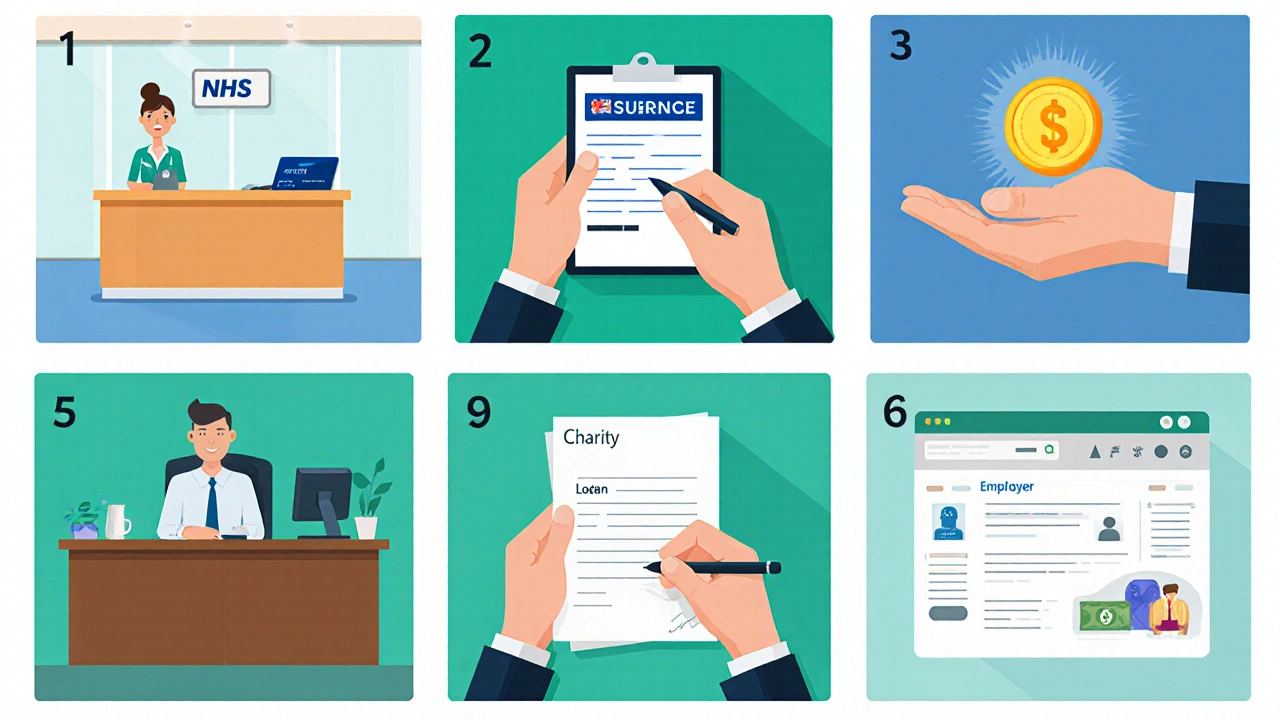IVF Cost Estimator
Your IVF Costs
Funding Options
Estimated Costs
Savings Potential
When the dream of starting a family hits a financial roadblock, many wonder IVF financing options. The price tag of in‑vitro fertilisation can feel overwhelming, especially when you add medication, monitoring appointments, and possible multiple cycles. Below we break down where the money goes, who can help, and realistic ways to keep the journey affordable.
What Makes IVF So Expensive?
IVF is in‑vitro fertilisation, a medical procedure that combines an egg and sperm outside the body to create embryos for transfer into the uterus. A single fresh cycle in the UK typically ranges from £5,000 to £8,000, but the real cost adds up when you consider:
- Baseline clinic fees - consultation, labs, and embryo culture.
- Medication - gonadotropins can be £2,500‑£4,000 per cycle.
- Monitoring - ultrasound and blood tests every few days.
- Frozen‑embryo storage - £150‑£250 annually.
- Additional procedures - ICSI, assisted hatching, or pre‑implantation genetic testing (PGT).
These figures are averages; boutique clinics in London can exceed £10,000 per fresh cycle, while some NHS centres offer reduced fees. Understanding the cost breakdown helps you target the right funding sources.
Public vs. Private: Where Can You Get IVF in the UK?
The NHS provides IVF for eligible couples, but eligibility criteria are strict. Typically, you must be under 40, have a body mass index (BMI) between 18‑30, and have been trying to conceive for at least two years. Even when you qualify, the NHS usually covers only a limited number of cycles (often three) and may not fund all medications.
Private fertility clinics give you more flexibility-no waiting lists, choice of protocols, and often higher success rates per cycle. However, the price is fully out‑of‑pocket unless you tap into other funding streams.
Funding Options Overview
Below is a snapshot of the most common ways people manage IVF costs in the UK.
| Option | Typical Coverage | Eligibility | Pros | Cons |
|---|---|---|---|---|
| NHS Funding | Up to 3 cycles, limited meds | Age < 40, BMI 18‑30, two‑year infertility | Low out‑of‑pocket cost | Long wait times, strict criteria |
| Health Insurance | Varies - may cover meds, some cycles | Policy terms, may need prior authorisation | Potentially reduces cash spend | Many UK policies exclude fertility |
| IVF Grants & Charities | Full or partial cycle costs | Income‑based, specific medical criteria | Free money, no repayment | Competitive applications, limited funds |
| Medical Loans | Up to full cost, repay over time | Credit check, interest rates apply | Immediate cash availability | Interest adds to total expense |
| Employer Assistance | Partial reimbursements, flexible spending | Employer‑provided benefit programs | Tax‑advantaged, no interest | Not all employers offer |
| Tax Relief (Self‑Assessment) | Offset of medical expenses | Must be eligible expense, record keeping | Reduces taxable income | Requires HMRC documentation |
| Crowdfunding | Variable - can cover full cost | Open to public donations | Emotional support, community reach | Uncertain amount, platform fees |
| Medical Tourism | Lower overall cost abroad | Willingness to travel, legal considerations | Potential savings of 30‑50% | Travel logistics, accreditation checks |
Insurance Coverage for IVF
In the UK, most private health insurance policies do not include fertility treatment, but a handful of specialist plans do. If you already have a private policy, check the fine print for terms like "reproductive health" or "IVF benefit". Some insurers will cover medication but not the clinic fees, which still leaves a sizable gap.
When evaluating insurance, ask these questions:
- Does the policy cover both fresh and frozen cycles?
- Are there caps per year or per lifetime?
- Is prior authorisation required?
If your insurer falls short, you can often purchase a supplemental fertility rider for an extra £200‑£500 annually.
Grants, Charities, and Government Schemes
Several UK charities award IVF grants. Notable examples include:
- Fertility Foundation - offers up to £3,000 for low‑income couples.
- Resolve - provides one‑off grants ranging £1,500‑£5,000 based on need.
- BBC Children in Need - occasional fertility‑related fundraising rounds.
Application processes usually require proof of income, a referral letter from your doctor, and a personal statement about why IVF is essential for you. Success rates vary; plan to apply early, as funds are limited and awarded on a rolling basis.

Medical Loans and Credit Options
Specialised medical lenders such as Lendwise and Future Finance offer loans tailored for fertility treatment. Typical terms:
- Loan amounts: £2,000‑£20,000.
- Interest rates: 4%‑12% APR, fixed or variable.
- Repayment periods: 12‑60 months.
Before borrowing, run the numbers. A £10,000 loan at 8% APR over 36 months adds about £1,200 in interest, pushing the total to £11,200. Compare that to your expected success rate; sometimes a lower‑interest personal loan from your bank might be cheaper.
Employer Assistance and Flexible Spending
Some forward‑thinking companies include fertility benefits in their employee packages. This can take the form of a direct reimbursement, an annual stipend (often £1,000‑£2,500), or a health‑savings account that can be used for IVF expenses. If your HR department isn’t advertising such perks, it never hurts to ask-especially if you can demonstrate the benefit to employee wellbeing and retention.
Tax Relief for Medical Expenses
HMRC allows you to claim tax relief on certain medical costs, including IVF, under the "self‑assessment" system. You’ll need:
- Official receipts from your clinic.
- A clear breakdown of what portion is classified as a medical expense.
- Documentation that the treatment was prescribed by a qualified specialist.
Claiming tax relief can shave off up to 45% of your out‑of‑pocket spend if you’re a higher‑rate taxpayer. Keep a dedicated folder for all invoices to simplify the process.
Crowdfunding and Community Support
Online platforms like GoFundMe and JustGiving have become popular for IVF fundraising. A well‑crafted story that explains your journey, includes photos, and updates donors on progress can raise anywhere from a few hundred to over £10,000.
Tips for a successful campaign:
- Set a realistic target-most campaigns succeed when the goal matches the actual cost.
- Share regularly on social media; transparency builds trust.
- Thank donors personally; it encourages sharing.
Remember, platforms usually take a 2%‑5% fee, so factor that in when calculating your net amount.
Medical Tourism: Cutting Costs Abroad
Countries like Spain, Greece, and the Czech Republic offer IVF at 30%‑50% lower prices while maintaining high standards. If you consider traveling, verify the clinic’s accreditation (e.g., ESHRE, ISO 9001) and ensure the legal framework protects your embryos and consent.
Typical cost breakdown for a full cycle in Eastern Europe ranges £3,000‑£4,500, with medication often included. Add travel and accommodation, and you may still save £2,000‑£3,000 compared to UK private rates. Factor in the emotional toll of being away from your support network, though many couples find the cost savings worthwhile.
Practical Tips to Reduce IVF Expenses
- Combine medication cycles: Some clinics allow a "dual stimulation" protocol, reducing the number of cycles needed.
- Opt for frozen embryo transfers (FET) after the first fresh cycle; they tend to be cheaper and have comparable success.
- Ask about generic medication alternatives; they can cut drug costs by up to 40%.
- Limit add‑ons unless medically necessary; procedures like PGT add £1,200‑£2,500 per cycle.
- Negotiate payment plans: Many clinics will split the bill into monthly installments without interest.
Building a Realistic IVF Budget
Start with a spreadsheet that captures:
- Clinic fees (baseline and per‑cycle).
- Medication estimates based on your doctor’s protocol.
- Potential add‑ons (ICSI, PGT, vitrification).
- Travel, accommodation, and lost‑wage costs if you’re traveling.
- Contingency fund (10%‑15% for unexpected expenses).
Next, map each line item to a funding source from the table above. For example, medication might be covered partially by a grant, while the clinic fee is financed through a loan. Seeing the whole picture helps you avoid hidden gaps that could stall treatment.
Common Pitfalls and How to Avoid Them
- Waiting for the perfect funding - Delays can reduce success rates as age advances. Combine sources early and start the first cycle while you still qualify for NHS assistance, if applicable.
- Over‑borrowing - Taking a high‑interest loan for optional add‑ons can lead to debt after the treatment ends. Prioritise core cycle costs first.
- Ignoring tax implications - Failing to claim eligible relief means you pay more than you need to.
- Skipping the fine print on grants - Some awards require you to repay if you achieve pregnancy within a set period.
- Choosing the cheapest clinic without checking success rates - A lower price may come with lower live‑birth rates, ultimately costing more if multiple cycles are needed.
Take the First Step Today
Affording IVF isn’t a myth; it’s a puzzle of costs, resources, and timing. Start by gathering your recent medical reports, list your monthly budget, and research at least two funding options that fit your situation. Reach out to a fertility counsellor-many clinics offer free financial consultations-to help you match the right mix of NHS coverage, grants, and personal financing. The sooner you map it out, the more control you have over both your wallet and your family‑building journey.
Can I use my private health insurance for IVF in the UK?
Only a small number of private insurers offer dedicated fertility add‑ons. Most standard policies exclude IVF, but you can often buy a supplemental rider for an extra premium. Always read the policy wording and check whether medication or clinic fees are covered.
What grants are available for low‑income couples?
Charities such as the Fertility Foundation, Resolve, and local NHS Trusts award one‑off grants ranging from £1,500 to £5,000. Applications typically require proof of income, a referral letter, and a personal statement. Funding is limited, so apply as early as possible.
Is medical tourism a safe way to cut IVF costs?
Yes, if you choose a clinic with recognized accreditation (ESHRE, ISO) and verify legal protections for embryos. Many couples save 30‑50% by travelling to Spain or the Czech Republic, but factor in travel, accommodation, and the emotional impact of being away from home.
Can I claim IVF expenses on my taxes?
HMRC permits tax relief on qualifying medical expenses, including IVF, if you file a self‑assessment. Keep all clinic invoices and a doctor’s prescription. The relief can reduce your taxable income by up to 45% for higher‑rate taxpayers.
How much does a typical UK IVF loan cost?
Specialist fertility loans range from £2,000 to £20,000 with interest rates between 4% and 12% APR. A £10,000 loan at 8% APR over 36 months adds roughly £1,200 in interest, making the total payable about £11,200.
